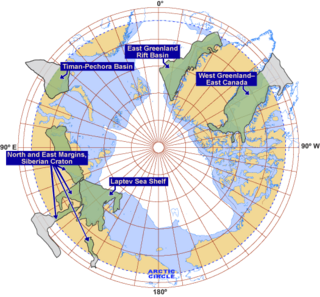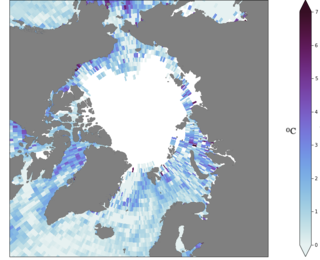
Nares Strait is a waterway between Ellesmere Island and Greenland that connects the northern part of Baffin Bay in the Atlantic Ocean with the Lincoln Sea in the Arctic Ocean. From south to north, the strait includes Smith Sound, Kane Basin, Kennedy Channel, Hall Basin and Robeson Channel. Nares Strait has a nearly permanent current from the north, powered by the Beaufort Gyre, making it harder to traverse for ships coming from the south.

Lincoln Sea is a body of water in the Arctic Ocean, stretching from Cape Columbia, Canada, in the west to Cape Morris Jesup, Greenland, in the east. The northern limit is defined as the great circle line between those two headlands. It is covered with sea ice throughout the year, the thickest sea ice in the Arctic Ocean, which can be up to 15 m (49 ft) thick. Water depths range from 100 m (330 ft) to 300 m (980 ft). Water and ice from Lincoln Sea empty into Robeson Channel, the northernmost part of Nares Strait, most of the time.

Totten Glacier is a large glacier draining a major portion of the East Antarctic Ice Sheet, through the Budd Coast of Wilkes Land in the Australian Antarctic Territory. The catchment drained by the glacier is estimated at 538,000 km2 (208,000 sq mi), extending approximately 1,100 km (680 mi) into the interior and holds the potential to raise sea level by at least 3.5 m (11 ft). Totten drains northeastward from the continental ice but turns northwestward at the coast where it terminates in a prominent tongue close east of Cape Waldron. It was first delineated from aerial photographs taken by USN Operation Highjump (1946–47), and named by Advisory Committee on Antarctic Names (US-ACAN) for George M. Totten, midshipman on USS Vincennes of the United States Exploring Expedition (1838–42), who assisted Lieutenant Charles Wilkes with correction of the survey data obtained by the expedition.

Exploration for petroleum in the Arctic is expensive and challenging both technically and logistically. In the offshore, sea ice can be a major factor. There have been many discoveries of oil and gas in the several Arctic basins that have seen extensive exploration over past decades but distance from existing infrastructure has often deterred development. Development and production operations in the Arctic offshore as a result of exploration have been limited, with the exception of the Barents and Norwegian seas. In Alaska, exploration subsequent to the discovery of the Prudhoe Bay oilfield has focussed on the onshore and shallow coastal waters.
Edward C. Carmack is a senior research scientist emeritus for the Department of Fisheries and Oceans in Sidney, British Columbia. He formally worked with the Institute of Ocean Sciences in Sidney, British Columbia and as an adjunct professor at the University of British Columbia.

The Arctic sea ice covers less area in the summer than in the winter. The multi-year sea ice covers nearly all of the central deep basins. The Arctic sea ice and its related biota are unique, and the year-round persistence of the ice has allowed the development of ice endemic species, meaning species not found anywhere else.

The Arctic Ocean is the smallest and shallowest of the world's five major oceans. It spans an area of approximately 14,060,000 km2 (5,430,000 sq mi) and is known as one of the coldest of oceans. The International Hydrographic Organization (IHO) recognizes it as an ocean, although some oceanographers call it the Arctic Mediterranean Sea. It has also been described as an estuary of the Atlantic Ocean. It is also seen as the northernmost part of the all-encompassing World Ocean.
Aker Arctic Technology Oy is a Finnish engineering company that operates an ice model test basin in Helsinki. In addition to ship model testing, the company offers various design, engineering and consulting services related to icebreakers, other icegoing vessels and arctic offshore projects as well as full scale trials, field expeditions and training for icy conditions. Formerly the arctic research centre of Wärtsilä and later Masa-Yards, Aker Arctic was established on 30 December 2004 as an independent company with Finnish Industry Investment Ltd, ABB and Aker Solutions as its current shareholders.

The Beaufort Gyre is one of the two major ocean currents in the Arctic Ocean. It is roughly located north of the Alaskan and Canadian coast. In the past, Arctic sea-ice would circulate in the Beaufort gyre up to several years, leading to the formation of very thick multi-year sea-ice. Due to warming temperatures in the Arctic, the gyre has lost an extensive amount of ice, practically turning what used to be a nursery for sea-ice to mature and grow into the thickest and oldest ice of the Arctic Ocean into a "graveyard" for older ice.
Fiona McLaughlin is a senior Oceanographer, employed by Canada's Department of Fisheries and Oceans. McLaughlin joined government service in 1972. Since 1994 she has concentrated on the ecology of the Arctic Ocean.
Carmen Gaina is the Director of the Centre for Earth Evolution and Dynamics (CEED) a Norwegian Centre of Excellence hosted at the Department of Geosciences, University of Oslo, Norway.

Lawrence Mysak, is a Canadian applied mathematician, working primarily on physical oceanography, and climate research, particularly arctic and palaeoclimate research.

Sea ice in the Arctic has declined in recent decades in area and volume due to climate change. It has been melting more in summer than it refreezes in winter. Global warming, caused by greenhouse gas forcing is responsible for the decline in Arctic sea ice. The decline of sea ice in the Arctic has been accelerating during the early twenty‐first century, with a decline rate of 4.7% per decade. It is also thought that summertime sea ice will cease to exist sometime during the 21st century.
Undersaturation is a state of a solution that contains less of a dissolved material than could be dissolved by that quantity of solvent under normal circumstances. It can also refer to a vapor of a compound that has a lower (partial) pressure than the compound's vapor pressure. Undersaturation is often followed by ingassing of the solvate until saturation is reached. Most states of solution involve undersaturation.
William Li is a Canadian biological oceanographer who did research on marine picoplankton, marine macroecology, ocean surveys of plankton from measurements of flow cytometry, and detection of multi-annual ecological change in marine phytoplankton.

Atlantification is the increasing influence of Atlantic water in the Arctic. Warmer and saltier Atlantic water is extending its reach northward into the Arctic Ocean. The Arctic Ocean is becoming warmer and saltier and sea-ice is disappearing as a result. The process can be seen on the figure on the far right, where the sea surface temperature change in the past 50 years is shown, which is up to 5 degrees in some places. This change in the Arctic climate is most prominent in the Barents Sea, a shallow shelf sea north of Scandinavia, where sea-ice is disappearing faster than in any other Arctic region, impacting the local and global ecosystem.
Bette Otto-Bliesner is an earth scientist known for her modeling of Earth's past climate and its changes over different geological eras.
Sukyoung Lee is a professor at Pennsylvania State University known for her research on circulation in Earth's atmosphere and the Southern Ocean. In 2021 Lee was elected a fellow of the American Geophysical Union.
Mary-Louise Elizabeth Timmermans is a marine scientist known for her work on the Arctic Ocean. She is the Damon Wells Professor of Earth and Planetary Sciences at Yale University.

The Last Ice Area is broadly the large interior polar region of the Arctic Circle covering an area between the northern edge of Greenland and the Canadian Arctic Archipelago and is the most northerly coastal zone of the world. Being in a permafrost landscape, it is the oldest and thickest ice sheet in the Arctic and is expected to persist longest as a sea ice. Towards the northern side, it consists of the Tuvaijuittuq Marine Protected Area, which is the largest protected area in Canada and among the largest protected areas in the world. It is one of the major centres of environmental concerns that is bound to have global impact. The Arctic Council's 2017 report Snow, Water, Ice and Permafrost. Summary for Policy-makers predicted that current rate of climate change will cause the complete disappearance of the ice within a century.











